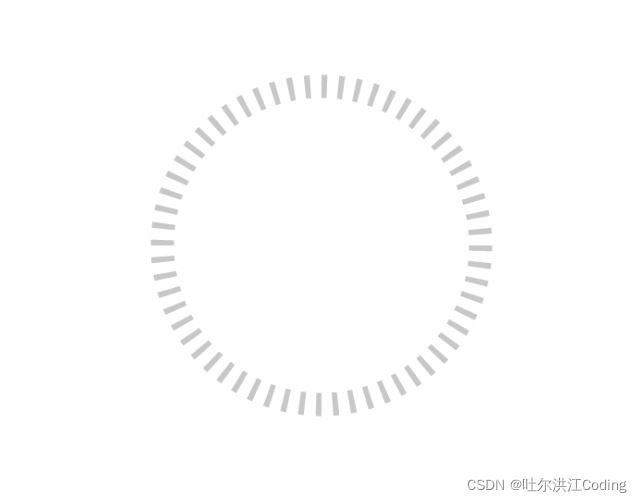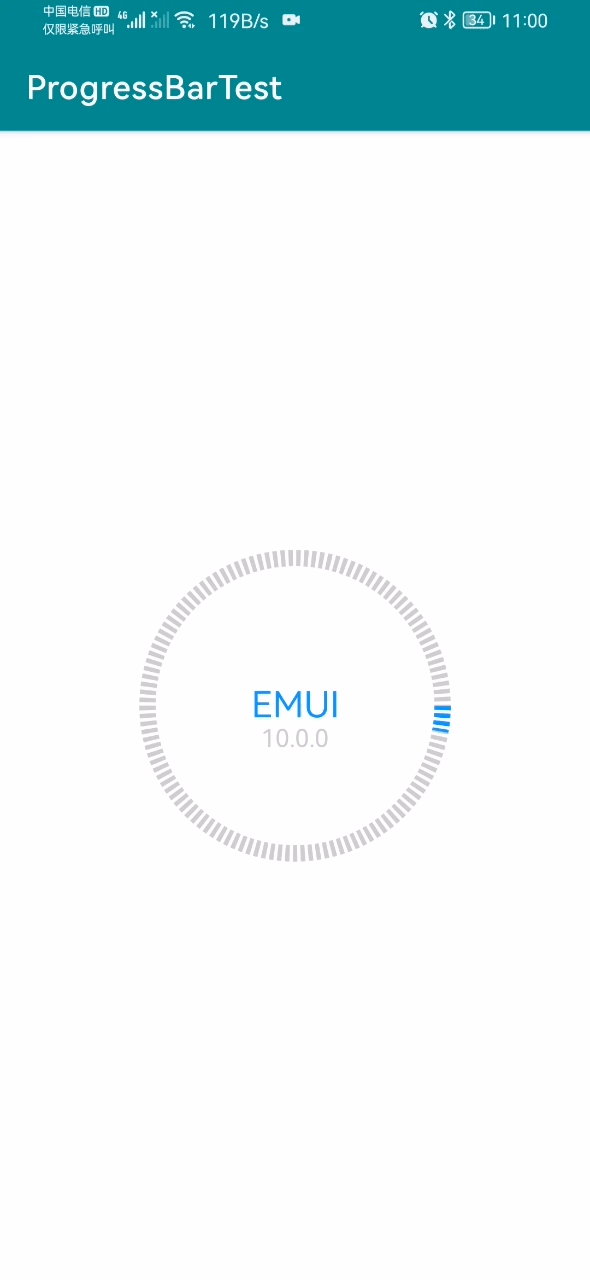前言
之前用华为Android系统的时候总是会想到这种虚线进度条是怎么实现的,因为直接用canvas的drawArc方法画出来的是实线,所以最近在网上搜了很多进度条相关的文章,也了解到了其中的原理,下面分享给大家。下面这两篇文章是我之前写的Android进度条相关的文章,有兴趣的朋友们可以看看:
Android实现绚丽的自定义进度条
详解Android如何自定义view实现圆形进度条
下面开始讲解虚线进度条的实现方法,首先看一张图:
实现步骤
大家可以先想想这种进度条是怎么实现的?网上有各种各样的方法,也有人用path的lineTo()方法实现了类似的效果。但是我个人觉得canvas的drawArc方法也是个不错的选择,适合自己的才是最好的。
canvas.drawArc(rectF, 0, process, false, mPaint);
阅读了大量文章,最后发现改变paint的样式是最简单好用的方法。给paint设置一个effect就好了。
1.用DashPathEffect给paint加上虚线效果
DashPathEffect dashPathEffect = new DashPathEffect(new float[]{8, 6}, 0);
mPaintBack.setPathEffect(dashPathEffect);
build一下项目,看到的结果是这样的:
能实现这个效果就大功告成了,如果看过我前面两篇文章的朋友们就知道,后面的步骤就简单了,加个进度条和动画效果就可以了。
private void drawBack(Canvas canvas) {
RectF rectF = new RectF(strokeWidth, strokeWidth, getWidth() - strokeWidth, getHeight() - strokeWidth);
PathEffect effects = new DashPathEffect(new float[]{8, 6}, 0);
mPaintBack.setPathEffect(effects);
canvas.drawArc(rectF, 0, 360, false, mPaintBack);
}
2.画出进度条
画进度条和画背景完全一样,只是画笔颜色和小点个数不一样。
代码如下:
private void drawProgress(Canvas canvas) {
RectF rectF = new RectF(strokeWidth, strokeWidth, getWidth() - strokeWidth, getHeight() - strokeWidth);
PathEffect effects = new DashPathEffect(new float[]{8, 6}, 0);
mPaint.setPathEffect(effects);
canvas.drawArc(rectF, 0, process, false, mPaint);
}
3.绘制文字
接下来是绘制文字,实现文字居中的效果。思路是计算出圆心,调用canvas.drawText的方法就能在canvas上面绘制文字了。这里不需要更新进度文字,所以就更省事了。
EMUI 下面的10.0.0也是一样的方法,只是给Y坐标加一下55,往下移一点就好。
//绘制文字
private void drawText(Canvas canvas) {
int mTxtWidth = getTextWidth();
int mTxtHeight = getTextHeight();
int x = getWidth() / 2 - mTxtWidth / 2;
int y = getHeight() / 2 + mTxtHeight / 4;
canvas.drawText(getResources().getString(R.string.defaultTextEmui), x, y, mPaintText);
}
//绘制下方文字
private void drawTextBlow(Canvas canvas) {
int mTxtWidth = getTextWidthBlow();
int mTxtHeight = getTextHeight();
int x = getWidth() / 2 - mTxtWidth / 2;
int y = getHeight() / 2 + mTxtHeight / 4 + 55;
canvas.drawText(getResources().getString(R.string.defaultTextBelow), x, y, mPaintTextLevel);
}
4.加入动画效果
/**
* 设置动画效果
*/
public void start() {
ValueAnimator valueAnimator = ValueAnimator.ofInt(0, 360);
valueAnimator.setDuration(duration);
valueAnimator.setInterpolator(new LinearInterpolator());
valueAnimator.addUpdateListener(animation -> {
process = (int) animation.getAnimatedValue();
invalidate();
});
valueAnimator.start();
}
最终效果:
完整代码
package com.example.floatingwindow.widget;
import android.animation.ValueAnimator;
import android.content.Context;
import android.graphics.Canvas;
import android.graphics.DashPathEffect;
import android.graphics.Paint;
import android.graphics.PathEffect;
import android.graphics.RectF;
import android.util.AttributeSet;
import android.util.TypedValue;
import android.view.View;
import android.view.animation.LinearInterpolator;
import androidx.annotation.Nullable;
import com.example.floatingwindow.R;
public class DottedLineProgressBar extends View {
private Paint mPaint;
private Paint mPaintBack;
private Paint mPaintText;
private Paint mPaintTextLevel;
private int strokeWidth = 30;
private int textSize = 22;
private int textSizeBlow = 15;
private long duration = 3500;
private int process;
public DottedLineProgressBar(Context context) {
super(context);
init();
}
public DottedLineProgressBar(Context context, @Nullable AttributeSet attrs) {
super(context, attrs);
init();
}
public DottedLineProgressBar(Context context, @Nullable AttributeSet attrs, int defStyleAttr) {
super(context, attrs, defStyleAttr);
init();
}
public void setStrokeWidth(int width) {
strokeWidth = width;
}
public void setTextSize(int textSize) {
this.textSize = textSize;
}
public void setDuration(long duration) {
this.duration = duration;
}
public void setTextSizeBlow(int textSizeBlow) {
this.textSizeBlow = textSizeBlow;
}
//初始化画笔
private void init() {
mPaintBack = new Paint();//圆角矩形
mPaintBack.setColor(getResources().getColor(R.color.gray));//圆角矩形颜色
mPaintBack.setAntiAlias(true);// 抗锯齿效果
mPaintBack.setStyle(Paint.Style.STROKE);//设置画笔样式
mPaintBack.setStrokeWidth(strokeWidth);//设置画笔宽度
mPaint = new Paint();
mPaint.setColor(getResources().getColor(R.color.blue));
mPaint.setAntiAlias(true);
mPaint.setStyle(Paint.Style.STROKE);
mPaint.setStrokeWidth(strokeWidth);
mPaintText = new Paint();
mPaintText.setAntiAlias(true);
mPaintText.setStyle(Paint.Style.FILL);
mPaintText.setColor(getResources().getColor(R.color.blue));
mPaintText.setTextSize(sp2px(textSize));
mPaintTextLevel = new Paint();
mPaintTextLevel.setAntiAlias(true);
mPaintTextLevel.setStyle(Paint.Style.FILL);
mPaintTextLevel.setColor(getResources().getColor(R.color.gray));
mPaintTextLevel.setTextSize(sp2px(textSizeBlow));
}
@Override
protected void onDraw(Canvas canvas) {
super.onDraw(canvas);
drawBack(canvas);
drawProgress(canvas);
drawText(canvas);
drawTextBlow(canvas);
}
private void drawBack(Canvas canvas) {
RectF rectF = new RectF(strokeWidth, strokeWidth, getWidth() - strokeWidth, getHeight() - strokeWidth);
PathEffect effects = new DashPathEffect(new float[]{8, 6}, 0);
mPaintBack.setPathEffect(effects);
canvas.drawArc(rectF, 0, 360, false, mPaintBack);
}
private void drawProgress(Canvas canvas) {
RectF rectF = new RectF(strokeWidth, strokeWidth, getWidth() - strokeWidth, getHeight() - strokeWidth);
PathEffect effects = new DashPathEffect(new float[]{8, 6}, 0);
mPaint.setPathEffect(effects);
canvas.drawArc(rectF, 0, process, false, mPaint);
}
//绘制文字
private void drawText(Canvas canvas) {
int mTxtWidth = getTextWidth();
int mTxtHeight = getTextHeight();
int x = getWidth() / 2 - mTxtWidth / 2;
int y = getHeight() / 2 + mTxtHeight / 4;
canvas.drawText(getResources().getString(R.string.defaultTextEmui), x, y, mPaintText);
}
//绘制下方文字
private void drawTextBlow(Canvas canvas) {
int mTxtWidth = getTextWidthBlow();
int mTxtHeight = getTextHeight();
int x = getWidth() / 2 - mTxtWidth / 2;
int y = getHeight() / 2 + mTxtHeight / 4 + 55;
canvas.drawText(getResources().getString(R.string.defaultTextBelow), x, y, mPaintTextLevel);
}
private int getTextWidth() {
String text = getResources().getString(R.string.defaultTextEmui);
return (int) mPaintText.measureText(text, 0, text.length());
}
private int getTextWidthBlow() {
String text = getResources().getString(R.string.defaultTextBelow);
return (int) mPaintTextLevel.measureText(text, 0, text.length());
}
private int getTextHeight() {
Paint.FontMetrics fm = mPaintText.getFontMetrics();
return (int) Math.ceil(fm.descent - fm.ascent);
}
private int sp2px(int sp) {
return (int) TypedValue.applyDimension(TypedValue.COMPLEX_UNIT_SP, sp,
getResources().getDisplayMetrics());
}
/**
* 设置动画效果
*/
public void start() {
ValueAnimator valueAnimator = ValueAnimator.ofInt(0, 360);
valueAnimator.setDuration(duration);
valueAnimator.setInterpolator(new LinearInterpolator());
valueAnimator.addUpdateListener(animation -> {
process = (int) animation.getAnimatedValue();
invalidate();
});
valueAnimator.start();
}
}
kotlin调用:
class MainActivity : AppCompatActivity() {
override fun onCreate(savedInstanceState: Bundle?) {
super.onCreate(savedInstanceState)
setContentView(R.layout.activity_main)
dottedLineProgressBar.post {
dottedLineProgressBar.start()
}
}
}
XML:
以上就是完整的实现过程了。
项目源码:https://gitee.com/tu_erhongjiang/android-progress-bar
到此这篇关于Android模拟实现华为系统升级进度条的文章就介绍到这了,更多相关Android进度条内容请搜索脚本之家以前的文章或继续浏览下面的相关文章希望大家以后多多支持脚本之家!




